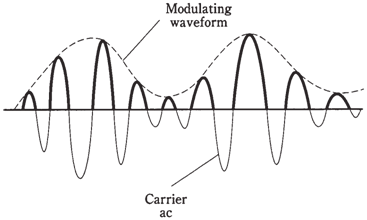Definition of detection
Detection, called as demodulation, is recovery of information such as audio, a visible image (may be still or moving), or printed data from the signal. In the manner this is done depends on modulation mode.
Detection of AM signals
The amplitude modulation is done by varying instantaneous strength of carrier wave. The fluctuations follow waveform of voice or video data. The carrier itself is alternating current, of a frequency many times that of modulating audio or video. The modulation peaks occur on positive and negative swings of carrier. This is shown in the figure given below.

Figure--An AM signal. The heavy lines show output after passing through envelope-detector diode or transistor.
If you feed AM carrier current directly into the headset, fax machine, you cannot recover the data as the positive and negative peaks come by in such rapid succession that they cancel each other.
An easy way to get the modulating waveform out of the AM signal is to cut off half of carrier wave cycle. The result is fluctuating, pulsating direct current. The pulsations occur at carrier frequency, the slower fluctuation is a repetition of modulating audio or video. This process is done by passing signal through a diode with a small capacitance so that it follows carrier frequency. A transistor, biased for class-B operation, can be used.The rapid pulsations are smoothed out by passing output of diode or transistor through the capacitor of the right value. The capacitance should be large so that it holds charge for one carrier current cycle, but not so large that it smoothes out cycles of modulating signal.This scheme is called as envelope detection. It is used extensively for the reception of AM audio and video.